When Do Marines Get to Wear Dress Blues
The Uniforms of the United States Marine Corps serve to distinguish Marines from members of other services. Among current uniforms in the United States Armed Forces, the Marines' uniforms have been in service the longest. The Marine Dress Blue uniform has, with few changes, been worn in essentially its current form since the 19th century.
At the start of World War II, the Marine Corps had four standard uniforms which are The Dress Blues, The Summer Service Uniform, The Winter Service Uniform and The Marine Utility Uniform. Dress Blues could be worn with a white canvas belt, a leather belt, or a blue cloth belt for officers, but their issue ceased in early 1942 except for recruiters and ceremonial units for the duration of the war.The green winter service uniform, issued with a coat and a shell cordovan belt for enlisted men with a Sam Browne belt for officers (until a cloth belt of the same material replaced both in 1943), was initially worn as a field uniform (such as the 1st Provisional Marine Brigade in Iceland wearing them daily). The garrison cap was introduced, originally to be worn overseas, but quickly became standard. The summer khaki service uniform featured pointed pocket flaps, as opposed to the Army's trousers having only front pockets.
Dress Blues [ ]
The Marine Corps takes rightful pride in the dress and deportment of its members. No other uniform defines the image of the Corps like dress blues. Trim, dashing and fit; the Marine wearing his blues was the symbol of the Corps for most Americans, especially in the prewar years.
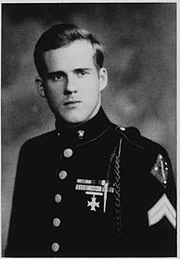
Cpl. Eugene Sledge poses for an official portrait with his enlisted's dress blues.
Leon Uris described it in his classic novel Battle Cry: "The Sea School Marines were a sight to make any boot cringe. Six feet tall, husky and tanned, they were the men who manned the guard of battleships and cruisers of the fleet. The air was alive with the color of their dress blues. Their sergeant rippled cadence from his tongue and in his hand swung a beautiful golden saber. The polish of their golden buttons and buckles, the mirror of their shoes and cap brims, the white of their belts and gloves and the magnificent unison of their movement was a sight to behold."
At odds with the public image, most World War II Marines never wore dress blues during their time in the service. Many expected to be issued a set when they reported to boot camp, especially those who enlisted early in the war. More than one Marine has reported his surprise in first learning that the Corps was uniformed in drab colors during the war.
Before the war, enlisted Marines were furnished with blues as part of their sea bag issue. Officers and warrant officers were required to purchase and maintain blues at their own expense. After issuance was suspended, Marines could buy their own, but there were few opportunities to wear them during the war.

The real Hugh Corrigan wearing an officer's dress blue.
For all ranks, the dress blue blouse had a standing collar. Officers' blouses had five buttons on the front fly and enlisted blouses had seven buttons. Officers' blouses had four pockets on the front and those for enlisted Marines had no pockets. Enlisted blouses had scarlet piping on the collar, front fly, epaulets and French cuffs. Officers' blouses were without these accoutrements.
The trousers were sky blue in color for enlisted Marines, warrant officers, and company and field grade officers. Trousers for enlisted Marines were issued with a button fly and no hip pockets. Stripes were sewn on the outer seam of the trousers based upon rank. Non-rated Marines wore the trousers without any stripe. Officers, warrant officers, and noncommissioned officers wore a one and one-half inch scarlet stripe on their trousers. General officers wore dark blue trousers with a black mohair stripe.
The Summer Service Uniform [ ]
The summer service uniform, known throughout the Marine Corps as "khakis," was first adopted for wear in 1904. Before the introduction of the utility uniform in 1941, khakis were worn not only in garrison, but also in field exercises and in combat. In temperate climates, this uniform was worn only between April-September. In tropical posts and stations of the Corps, it was worn year-round. Khakis were authorized as the working uniform, and also for leave and liberty.
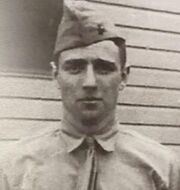
The real "Runner" Conley wearing a summer service uniform.
In the early campaigns of World War II, including Wake Island, the Philippines, and Guadalcanal, khakis were worn in combat. After the utility uniform was adopted, khakis were worn as an "all purpose" uniform in field and garrison. Although khakis were thereafter seldom worn by infantry units in combat, they were worn almost everywhere else in the Pacific.
For enlisted Marines, the summer service uniform consisted of a long sleeve shirt and trousers. Both were constructed of 100% cotton. The shirt had two flapped pockets on the chest and a convertible collar. The trousers had two side pockets. As standard with all enlisted service and dress trousers, there were no back pockets.

P.Sgt Elmo Haney receiving a medal. He's wearing a summer service uniform
Officers were permitted by regulation to wear either the same uniform as enlisted Marines, or to procure their own officers's quality khakis. They sometimes wore uniforms made of gabardine, and worsted wool blends.
In many camps and stations, Marines lived in tents. They often didn't have access to electricity and irons. To press their khakis, they sometimes resorted to "cot pressing." This entailed laying their shirts and trousers flat on their cots under the cot pad. They would then sleep on the uniform, using their body weight to flatten the worst wrinkles.
The Winter Service Uniform [ ]
The winter service uniform was the Marine Corps' standard uniform for wear in garrison, on leave and liberty and for all occasions when the utility uniform was not prescribed. It was worn from September–April in most temperate locations.
This uniform was in the traditional forest green color specific to the Corps, giving it the nickname, "greens." Forest green service uniforms were first adopted by the Marine Corps in 1912. Prior to World War II the service uniform was worn not only in garrison, but also in field training and combat.
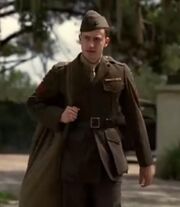
Cpl. Eugene Sledge wearing his Winter Service Uniform as he walks home.
Many of the young men who joined the Marine Corps, especially in the early part of the war, assumed that the standard uniform was dress blues. But Headquarters, Marine Corps instructed all units to cease issuance of dress blues on 6 August 1942 for the duration of the war. Marines who already had a set of blues were allowed keep them until worn out. After that date, any Marine who wanted a set of blues had to buy them.
This uniform consisted of a semi-form fitting four-pocket blouse with matching green trousers. The khaki shirt and field scarf were worn under the blouse. The garrison belt, also called "the fair leather belt," was also worn by enlisted Marines with greens. This belt had a heavy brass buckle that sometimes proved useful in bar fights. Officers wore either a green cloth belt with brass buckle, or the Sam Browne belt when wearing their swords.
Enlisted Marines received an initial seabag issue of uniforms and equipment when they first shipped into the Corps. For the duration of their service, all reissue and replacement of uniforms and equipment was without cost to them. Officers received a small initial allowance when they first joined the Marine Corps to purchase required uniforms. Thereafter, officers were required to buy uniforms at their own expense.
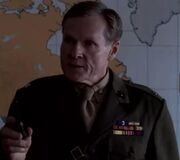
Lt. Col. Lewis Puller addressing his Marines. He is wearing the Winter Service Uniform.
The enlisted winter service uniform was made of heavyweight kersey wool. Officers were permitted to purchase uniforms in optional fabrics, such as gabardine, and wool serge. All Marines took great pride in their appearance and uniforms were tailored to the individual Marine.
The 1941 Pattern Utility Uniform [ ]
Prior to 1941, the Marine Corps did not have a specific field uniform. Marines in combat and field training wore the winter or summer service uniform, depending on the time of year, and geographic location. During the early battles of World War II, Marines in combat wore the summer service uniform with the World War I-style M1917A1 steel helmet. The 1941 pattern utility uniform was standardized for wear on 7 November 1941. It was originally intended to be a general purpose work uniform to be worn over the service uniform for working parties, field day, etc. But it quickly supplanted the service uniform for field wear. The utility uniform gave the World War II Marine a workmanlike appearance. It was simple, easy to maintain, and devoid of any frills or unnecessary features.
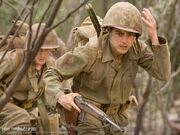
Pfc. Merriel Shelton wearing the utility uniform in Peleliu.
The 1941 pattern utility uniform was a two piece suit made of heavy, sage green, herringbone twill cotton. The jacket had three flapless pockets, one on the left chest, and two on the front hips. It was secured by four metal, riveted buttons embossed with "U. S. Marine Corps", though the top button near the collar was rarely fastened. The trousers had a button fly with four pockets. There were several arrangements of pockets on the trousers, depending upon manufacturer.
The utility uniform had superior wearing and camouflage characteristics. It was well suited to conditions in the Pacific campaigns. Marines wore it for all evolutions, from field training to combat. As a consequence, the service uniform was reserved for formal occasions, liberty, leave, etc.
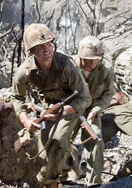
Capt. Andrew Haldane wearing his "dungarees" in Peleliu.
The environment that Marines fought in was harsh on uniforms and equipment. Utilities quickly faded to an aged appearance. Sometimes, Marines sped up the process by washing their clothes in sea water to give them a "salty" look. In combat, they dispensed with everything that was not absolutely necessary. For example, leggings were often discarded. They were difficult to lace on when wet, took a long time to dry and chafed the ankles in the heat. Sometimes, Marines rolled up their trouser legs, but not always.
During the war, the word "dungarees" was the common nickname for this uniform in keeping with the nautical heritage of the Corps. Marines also frequently called the uniform simply, "utilities." It was never called "fatigues," this being an Army word.
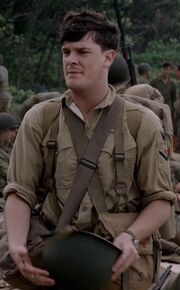
A Navy Corpsman attached with the Marines in Guadalcanal (such as Lewis here) also wears the same utilities as the Marines.
Navy medical personnel assigned to the Fleet Marine Force wore the same uniforms and equipment as Marines. There was no specific identifying mark for Navy personnel, barring early war uniforms and equipment, such as the Navy version of utility uniforms, simply marked with Navy markings in place of USMC markings on pockets and buttons, and the USN-issued medical bags marked with a red cross and U.S.N (14-280 Medical Case); their uniforms were issued through Marine Corps supply channels. Corpsmen issued equipment was quickly replaced when originals were damaged and supply was available. The USN medical bag was also quickly phased out due to them being far too small to hold enough equipment for long-haul engagements without supplies. The medical case was replaced by specially designed, deep pocket, corpsman bags similar to army ones, but nearly twice as deep. While they were issued in pairs of two, identical, left and right pieces, most corpsmen almost immediately dropped the second bag and yoke in exchange for a single general purpose strap attached to the D-rings slung over the shoulder in an attempt to conceal their role, as the Japanese notoriously targeted medical personnel, who were deemed non-combatants by the Geneva Conventions. This is also the reason for medical personnel of all types and forces did not wear any universally recognized medical symbol, such as the red cross. Many corpsmen removed their Naval rank markings on their uniforms or wore USMC utilities with small or medium sized white circles in special areas to show only those "in the know" their role, though that was not as common as one might assume. Instead, most simply dressed like, and acted like, the Marines they followed into battle, carrying their medical equipment in whatever was suitable and appropriately concealed as not to become too big of a target themselves. Examples of things used include general ammunition pouches, ammunition vests, uniform pockets, BAR and M1 Garand ammunition belts, small bandages and other equipment in helmet liners, etc.
Source: [ ]
http://www.ww2gyrene.org/equipment.htm
Source: https://thepacific.fandom.com/wiki/Uniforms_depicted_in_The_Pacific
0 Response to "When Do Marines Get to Wear Dress Blues"
Post a Comment